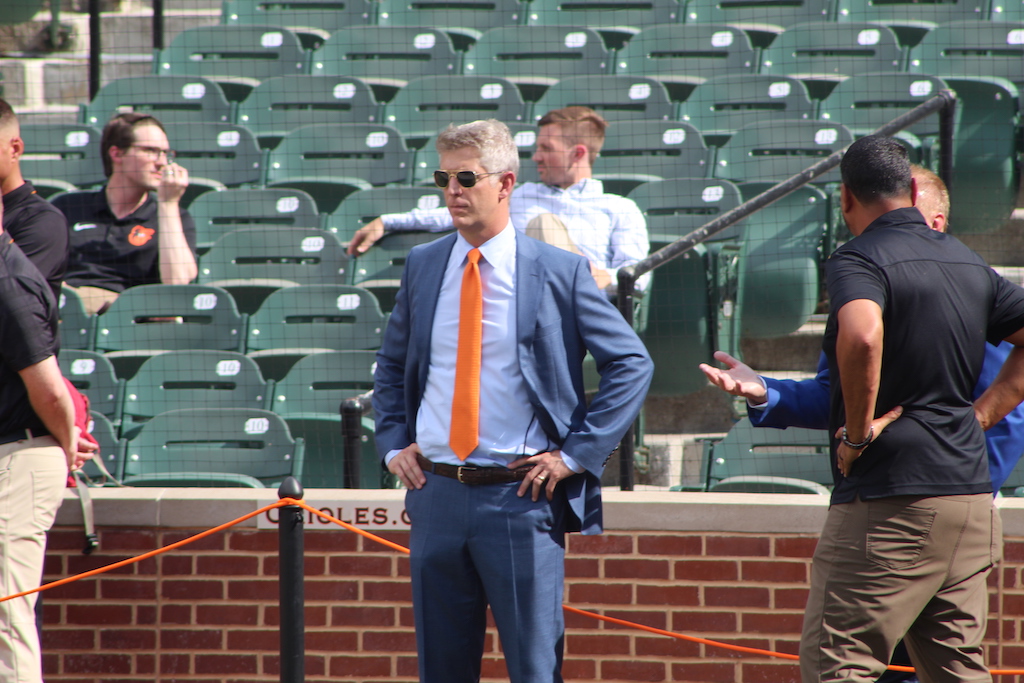
Is a deal for the Orioles inevitable?
When we look at the Orioles’ potential Opening Day roster as 2024 approaches, we can see how packed it is between Triple-A and the majors. This year, it will be difficult to find playing time for everyone who is skilled enough to make the roster.
It’s been mentioned before, but having too much skill doesn’t seem to be a problem, except when it comes to getting all those players on the field.
The Orioles have rebuilt their major league squad while developing an excellent talent pipeline and the baseball’s best farm system. They’re good, deep, and skilled, and it’s becoming increasingly difficult for certain kids to break in.
Only a few years ago, the rebuilding Orioles were giving playing time to players whose resumes would today be unlikely to obtain playing time. In Birdland, the seasons have changed.
If the Orioles start the season with two catchers and four outfielders (five seems more plausible), they might carry seven infielders. Gunnar Henderson, Jorge Mateo, Ryan Mountcastle, Ryan O’Hearn, Joey Ortiz, Ramón Uras, and Jordan Westburg are their current infielders on the 40-man roster.
So Jackson Holliday isn’t among the seven. Connor Norby and Coby Mayo are not among them. Terrin Vavra is not among them. Not to mention the outfield, where young players like Colton Cowser and Heston Kjerstad may see increased playing time.
Last season, infield prospect Westburg made his long-awaited debut in the major leagues. During the 2022 and 2023 seasons in Triple-A Norfolk, he had 714 plate appearances.
That was a lot, to be sure. But there was a period in O’s history when breaking through appeared even more difficult. That was back in 1969-1971, when the team won 100 games or more three straight years and appeared in the World Series all three seasons.
In 1970, future O’s Hall of Famer Bobby Grich played 63 games at Triple-A Rochester, batting .383 with an OPS of 1.074. His OPS was .563 in 30 games with Baltimore. The next year he was back at Triple-A, batting .336 with an OPS of 1.071 in 130 more games on the farm and he went 9-for-30 with Baltimore.
In 1970, Don Baylor played in 140 games at Rochester, batting .327/1.011 and he played eight games with the Orioles. The next season, he was back at Triple-A, batting .313/.961 in 136 games and played just one game in Baltimore.
Over those two years, Grich took 864 plate appearances in the minors and Baylor had 1,202 plate appearances at Rochester.
Talk about having a hard time getting to the bigs! We thought Westburg had a long wait.
The infield depth seems to be leading to one conclusion – a trade is coming. Because it has not so far doesn’t mean it won’t. But the Orioles don’t have to make a trade, which puts them in good bargaining position. Mike Elias stated during the Winter Meetings that they can trade with just about any club in the majors in terms of their strong minor league depth and strong prospects list.
Teams often look to make trades from their depth – trade that of which you have a surplus.
The O’s prospects lists with infielders and outfielders shows plenty of depth. Less so probably among the arms.
To me, considering the depth of talent here, a deal seems likely, almost inevitable.
There will be a segment of Birdland that will want to hoard every good prospect and is fearful of trading any of them. And you never win all trades. But moving young talent is part of the game for winning clubs and it is one reason the best organizations can stay on top year after year. And yes, higher payrolls clearly factors in as well for the big market boys. But producing that talent pipeline is a huge reason the O’s got back to the top of the American League East and keeping the pipeline flowing is how they can stay on top.
Players like Norby and Mayo do not need to be protected from the Rule 5 draft until November 2024, so the club could keep them on the farm again this coming year as they keep pushing closer to the majors. There are a lot of ways the organization can go here.
They have an abundance of young talent. Yes, it’s a good problem, but it’s still a bit of a problem that has to work itself out eventually.
Leave a Reply